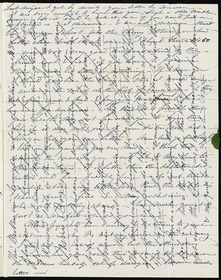
Accessing Complex & Informational Texts
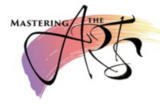
This resource was created by Kate Chrisman, in collaboration with Lynn Bowder, as part of ESU2's Mastering the Arts project. This project is a four year initiative focused on integrating arts into the core curriculum through teacher education and experiential learning.
- Subject:
- English Language Arts
- Visual Arts
- Material Type:
- Lesson
- Author:
- Arts ESU2
- Date Added:
- 09/02/2021
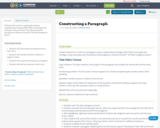
Students will construct a paragraph using an organizational strategy (TIQA-TIQA-C) and apply that strategy as they write about and characterize the protagonist in Richard Connell's "The Most Dangerous Game."
- Subject:
- English Language Arts
- Material Type:
- Activity/Lab
- Lesson Plan
- Date Added:
- 10/06/2015
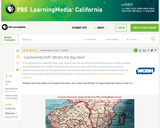
In this lesson designed to enhance literacy skills, students learn how the theory that explains the position of Earth's continents was established and later modified, and gain important insights into how science and the scientific community operate.
- Subject:
- English Language Arts
- Geoscience
- Language, Grammar and Vocabulary
- Physical Science
- Space Science
- Material Type:
- Activity/Lab
- Provider:
- PBS LearningMedia
- Provider Set:
- PBS Learning Media Common Core Collection
- Author:
- Leon Lowenstein Foundation
- WGBH Educational Foundation
- Walmart Foundation
- Date Added:
- 11/17/2010
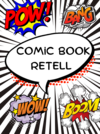
In this Unit Plan, Students will use Book Creator to create a comic of the story they have independently read in class. Students will independently use the resource I generated on how to use each function to create their comic. Then use the Criteria for Success ( cfs) to evaluate their own work, and share their work to peers.
- Subject:
- Arts and Humanities
- Elementary Education
- Graphic Arts
- Reading Foundation Skills
- Reading Literature
- Special Education
- Material Type:
- Activity/Lab
- Homework/Assignment
- Author:
- PatriciaAnn McCaffrey
- Date Added:
- 03/27/2022

Overview: In this lesson, students closely examine Crevecoeur’s third letter in order to understand historically early American literature and the culture. Students critically read the letter and answer critical content questions to increase their knowledge. Students will take a quiz demonstrating their understanding of some of the literature of this period. Finally, in the spirit of early America, students will write their own letters defining what an American is, why immigrants should come, and what the American Dream is or if it is still alive. Students will exchange their letters with a partner for feedback and then turn them in for completion points.
- Subject:
- English Language Arts
- Material Type:
- Lesson Plan
- Author:
- Judy Lorenzen
- Date Added:
- 07/27/2020

Middle and High School educators from across Lebanon County, Pennsylvania developed lesson plans to integrate the Pennsylvania Career Education and Work Standards with the content they teach. This work was made possible through a partnership between the South Central PA Workforce Investment Board (SCPa Works) and Lancaster-Lebanon Intermediate Unit 13 (IU13) and was funded by a Teacher in the Workplace Grant Award from the Pennsylvania Department of Labor and Industry. This lesson plan was developed by one of the talented educators who participated in this project during the 2019-2020 school year.
- Subject:
- Criminal Justice
- Material Type:
- Activity/Lab
- Author:
- Rachael Haverstick
- Matthew Bishop
- Date Added:
- 06/03/2020
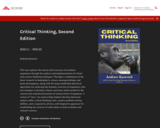
MHCC - WR122
Short Description:
This text explores the nature and structures of academic arguments through the analysis and implementation of critical and creative thinking techniques. Through a combination of the latest research in hemispheric science, neuropsychology, and brain development, along with the long-established rhetorical algorithms for analyzing the dynamic structure of arguments, this text attempts to develop a clearer and more robust model for the construction and deconstruction of various forms of argument. A variety of "texts" are used to help students develop rhetorical analysis skills, critical thinking tools, creative problem solving abilities, and a responsive, diverse, and integrative apparatus for establishing the veracity of truth claims in both academic and cultural contexts.
Word Count: 16779
(Note: This resource's metadata has been created automatically by reformatting and/or combining the information that the author initially provided as part of a bulk import process.)
- Subject:
- Composition and Rhetoric
- English Language Arts
- Material Type:
- Textbook
- Provider:
- MHCC
- Author:
- Andrew Gurevich
- Date Added:
- 03/01/2023

This a a cross curricular unit encompassing English, History, and Math Common Core Standards to teach the Child Labor practices of 1800s U.S. with the tragedy of Triangle Shirtwaist Factory Fire of 1911 which lead to child labor reform throughout the world and into the modern era.
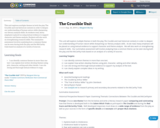
This unit explores multiple themes in both the play The Crucible and real historical contexts in order to deepen our understanding of human nature while sharpening our literary analysis skills. As students read, heavy emphasis is placed on using textual evidence to support character and theme analysis. Students will also work on strengthening research skills. The summative assessment involves analyzing how a common theme can be seen during both the play and the McCarthy trials based on analysis of a variety of sources.
- Subject:
- English Language Arts
- Material Type:
- Unit of Study
- Date Added:
- 07/22/2019

The Cultivating Washington curriculum is intended to be a go-to resource for Washington state middle school educators seeking student-centered instructional materials that make learning about the history of the Pacific Northwest more relevant and meaningful for students.In addition, it is a resource for agricultural education teachers, parents, and community members interested in helping students discover the history and development of agriculture in the state of Washington.
- Subject:
- Agriculture
- Career and Technical Education
- Cultural Geography
- Economics
- Political Science
- Social Science
- U.S. History
- Material Type:
- Lesson
- Lesson Plan
- Module
- Teaching/Learning Strategy
- Unit of Study
- Author:
- Barbara Soots
- Washington OSPI OER Project
- Jerry Price
- Date Added:
- 09/02/2020

Middle school is a conflict-ridden stage, particularly for our emerging bilingual students, who are normally known as ELLs. Not only do they have to overcome numerous problems of linguistic and cultural adaptation, but they also have to face challenges such as family or economic instability and moves, often cross-border. Indeed, it is not uncommon to meet Hispanic students: Mexicans, Puerto Ricans, Salvadorans, etc. who travel to their countries of origin, or to the countries of origin of their parents for seasons, sometimes even to stay and live there, despite having been born in the United States and having lived here all their schooling until that moment. It is also quite common to see students who migrate with their families to the United States when they are already 11 or 12 years old and who, as we mentioned, not only have to learn the language, but adapt to a new life, culture and traditions.In this lesson plan we propose to use these personal experiences to introduce basic conversational vocabulary. It is designed for both dual immersion programs and English development classes.
- Subject:
- Language Education (ESL)
- Material Type:
- Lesson
- Author:
- Sergio Cano Soto
- Kari Kaldahl
- Oregon Open Learning
- Date Added:
- 06/07/2022
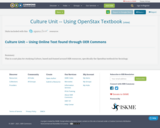
This is a unit plan for studying Culture, based and framed around OER resources, specifically the OpenStax textbook for Sociology.
- Subject:
- Social Science
- Material Type:
- Unit of Study
- Date Added:
- 01/29/2018
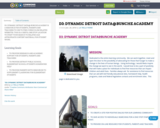
D3: DYNAMIC DETROIT DATA@ BUNCHE ACADEMY IS A RESOURCE FOR STUDENTS, PARENTS AND TEACHERS TO USE TO FIND CURRICULUM RELATED WEBSITES. THIS IS A USEFUL ONE STOP LOCATION TO START YOUR SEARCH TO RELATED AGE APPROPRIATE CONTENT MATERIAL FOR STUDENT WORK.
- Subject:
- Arts and Humanities
- Mathematics
- Social Science
- Material Type:
- Activity/Lab
- Diagram/Illustration
- Homework/Assignment
- Lecture Notes
- Teaching/Learning Strategy
- Date Added:
- 10/09/2012
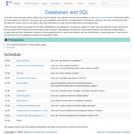
Software Carpentry lesson that teaches how to use databases and SQL In the late 1920s and early 1930s, William Dyer, Frank Pabodie, and Valentina Roerich led expeditions to the Pole of Inaccessibility in the South Pacific, and then onward to Antarctica. Two years ago, their expeditions were found in a storage locker at Miskatonic University. We have scanned and OCR the data they contain, and we now want to store that information in a way that will make search and analysis easy. Three common options for storage are text files, spreadsheets, and databases. Text files are easiest to create, and work well with version control, but then we would have to build search and analysis tools ourselves. Spreadsheets are good for doing simple analyses, but they don’t handle large or complex data sets well. Databases, however, include powerful tools for search and analysis, and can handle large, complex data sets. These lessons will show how to use a database to explore the expeditions’ data.
- Subject:
- Applied Science
- Computer Science
- Information Science
- Mathematics
- Measurement and Data
- Material Type:
- Module
- Provider:
- The Carpentries
- Author:
- Amy Brown
- Andrew Boughton
- Andrew Kubiak
- Avishek Kumar
- Ben Waugh
- Bill Mills
- Brian Ballsun-Stanton
- Chris Tomlinson
- Colleen Fallaw
- Dan Michael Heggø
- Daniel Suess
- Dave Welch
- David W Wright
- Deborah Gertrude Digges
- Donny Winston
- Doug Latornell
- Erin Alison Becker
- Ethan Nelson
- Ethan P White
- François Michonneau
- George Graham
- Gerard Capes
- Gideon Juve
- Greg Wilson
- Ioan Vancea
- Jake Lever
- James Mickley
- John Blischak
- JohnRMoreau@gmail.com
- Jonah Duckles
- Jonathan Guyer
- Joshua Nahum
- Kate Hertweck
- Kevin Dyke
- Louis Vernon
- Luc Small
- Luke William Johnston
- Maneesha Sane
- Mark Stacy
- Matthew Collins
- Matty Jones
- Mike Jackson
- Morgan Taschuk
- Patrick McCann
- Paula Andrea Martinez
- Pauline Barmby
- Piotr Banaszkiewicz
- Raniere Silva
- Ray Bell
- Rayna Michelle Harris
- Rémi Emonet
- Rémi Rampin
- Seda Arat
- Sheldon John McKay
- Sheldon McKay
- Stephen Davison
- Thomas Guignard
- Trevor Bekolay
- lorra
- slimlime
- Date Added:
- 03/20/2017
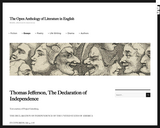
The unanimous Declaration of the thirteen united States of America.
- Subject:
- English Language Arts
- Material Type:
- Reading
- Provider:
- The Open Anthology of Literature in English
- Author:
- Thomas Jefferson
- Date Added:
- 07/10/2017
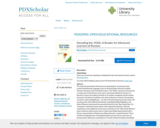
The materials presented in this book were developed for an advanced-level content-based Russian language course at Portland State University entitled “Russian Literature of the Twentieth Century: The 1920s.” Literature of this period is a major part of the Russian canon, but is notoriously difficult for learners of Russian to read in the original, due both to its stylistic complexity and the relative obscurity of its historical, political, and cultural references. And yet, this decade is crucial for understanding Russia – not only in the Soviet period, but also today. This was the period, when Mikhail Zoshchenko, Isaak Babel, Mikhail Bulgakov, and Andrei Platonov meticulously documented the birth of the “New Soviet Man,” his “newspeak” and Soviet bureaucratese; when Alexandra Kollontai, a Marxist revolutionary and a diplomat, wrote essays and fiction on the “New Soviet Woman”; when numerous satirical works were created; when Babel experimented with a literary representation of dialects (e.g.,Odessa Russian or Jewish Russian). These varieties of language have not disappeared. Bureaucrats still use some form of bureaucratese. Numerous contemporary TV shows imitate the dialects that Babel described. Moreover, Bulgakov’s “Heart of a Dog” gave rise, due largely to its film adaptation, to catch-phrases that still appear throughout contemporary Russian media, satirical contexts, and everyday conversation. Thus, the Russian literature of the 1920s does not belong exclusively to the past, but has relevance and interpretive power for the present, and language learners who wish to pursue a career in humanities, media analysis, analytical translation, journalism, or international relations must understand this period and the linguistic patterns it established.
The textbook is intended for adult learners, and contains language assignments that would, on the one hand, help students transition to ACTFL’s Advanced proficiency level (i.e., be able to create "narratives, descriptions, and summaries … using paraphrasing and elaboration” (ACTFL 2012: 12).), but at the same time promote meaningful engagement with literary texts. The assignments in this textbook are multilevel ones, and thus offer a solution for multilevel classes that include literate heritage Russian speakers, Intermediate High, Advanced, or even Superior-level readers.
- Subject:
- Arts and Humanities
- Languages
- Material Type:
- Textbook
- Provider:
- Portland State University
- Author:
- Nila Friedberg
- Date Added:
- 11/18/2021
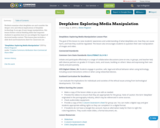
Students examine what deepfakes are and consider the deeper civic and ethical implications of deepfake technology. In an age of easy image manipulation, this lesson fosters critical thinking skills that empower students to question how we can mitigate the impact of doctored media content. This lesson plan includes a slide deck and brainstorm sheet for classroom use.

Definitions are a part of daily life, academics, and careers. How do they work? What makes an effetive definition. Students examine examples of definitions and revise them to learn about options for writing clearly for varied audiences. Finally, students create their own expanded definition.
- Subject:
- Business and Communication
- Communication
- Composition and Rhetoric
- Language, Grammar and Vocabulary
- Material Type:
- Module
- Author:
- Molly Berger
- Date Added:
- 12/31/2020
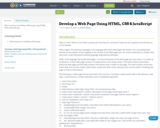
Short exercise on building a Web page using HTML, CSS, and JavaScript.
- Subject:
- Career and Technical Education
- Material Type:
- Activity/Lab
- Date Added:
- 03/28/2017
